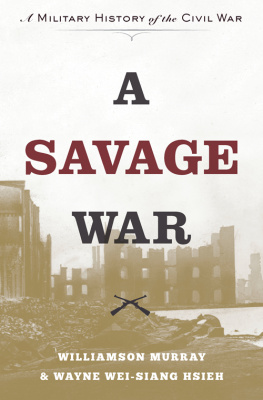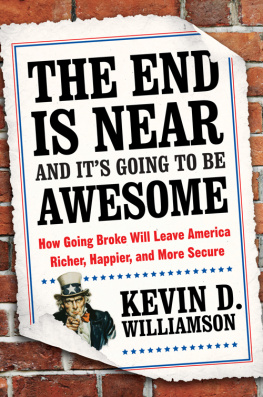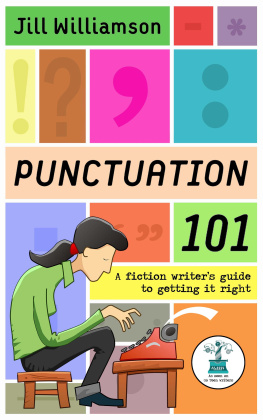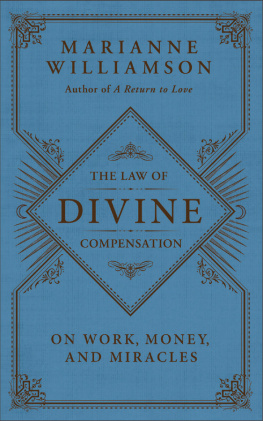Praise forAmerica and the Future of War
While Americas leaders display scant understanding of war, Williamson Murray again provides an unflinching book exposing realities we cannot ignore. The breadth and clarity of this richly researched primer packs lens-changing messages on every page, reflecting the authors extraordinary analytic rigor and historical insight. A must-read if were to escape the morass of nonstrategic thinking endangering our future.
General James Mattis, US Marine Corps (ret.)
This short but wide-ranging book is a like a necessary splash of cold water in the face of the academic and military establishments. There is the drama of a great, take-no-prisoners essay about it. The future of war, the author rightly says, will be like the past: bloody and unpredictable.
Robert D. Kaplan, senior fellow, Center for a New American Security and author of The Coming Anarchy and The Revenge of Geography
A superbly written analysis of how the world that we inhabit could go terribly wrong in the decades ahead. For those who think major wars are now impossible because of the democratic peace or nuclear deterrence, Murray cautions us to look at history and think again. America and the Future of War should be mandatory reading for all senior political and military leaders, including those in Congress, the executive branch, and all four military services.
Peter Mansoor, colonel, US Army (ret.) General Raymond E. Mason Jr. Chair of Military History Ohio State University
Williamson Murrays aim in America and the Future of War is twofold: he offers a tragic reminder to often therapeutic- minded Americans that war is inherent in the human condition and cannot be legislated or thought away. But he also offers a second practical blueprint of how the United States, through military readiness, deterrence, a balance of power, and muscular alliances, can prevent or at least mitigate hostile aggression. A tour de force of historical insight and political acumen.
Victor Davis Hanson, Martin and Illie Anderson Senior Fellow in Classics and Military History, Hoover Institution
AMERICA and the FUTURE of WAR
The Hoover Institution gratefully acknowledges
the following individuals and foundations
for their significant support of the
HERBERT AND JANE DWIGHT WORKING GROUP ON ISLAMISM AND THE INTERNATIONAL ORDER:
Herbert and Jane Dwight
Donald and Joan Beall
Beall Family Foundation
S. D. Bechtel, Jr. Foundation
Lynde and Harry Bradley Foundation
Stephen and Susan Brown
Lakeside Foundation

With its eminent scholars and world-renowned library and archives, the Hoover Institution seeks to improve the human condition by advancing ideas that promote economic opportunity and prosperity, while securing and safeguarding peace for America and all mankind. The views expressed in its publications are entirely those of the authors and do not necessarily reflect the views of the staff, officers, or Board of Overseers of the Hoover Institution.
www.hoover.org
Hoover Institution Press Publication No. 674
Hoover Institution at Leland Stanford Junior University,
Stanford, California, 943056003
Copyright 2017 by the Board of Trustees of the
Leland Stanford Junior University
All rights reserved. No part of this publication may be reproduced, stored in a retrieval system, or transmitted in any form or by any means, electronic, mechanical, photocopying, recording, or otherwise, without written permission of the publisher and copyright holders.
For permission to reuse material from America and the Future of War: The Past as Prologue, by Williamson Murray, ISBN 978-0-8179-2004-3, please access www.copyright.com or contact the Copyright Clearance Center, Inc. (CCC), 222 Rosewood Drive, Danvers, MA 01923, (978) 7508400. CCC is a not-for-profit organization that provides licenses and registration for a variety of uses.
First printing 2017
23 22 21 20 19 18 179 8 7 6 5 4 3 2 1
Manufactured in the United States of America
Cataloging-in-Publication Data is available from the Library of Congress.
ISBN 978-0-8179-2004-3 (cloth : alk. paper)
ISBN 978-0-8179-2006-7 (EPUB)
ISBN 978-0-8179-2007-4 (Mobipocket)
ISBN 978-0-8179-2008-1 (PDF)
CONTENTS
Dedication
To General Jim Mattis and the Soldiers, Marines, Sailors, and Airmen who by their acuity, blood, sweat, and tears will protect this great Republic over the coming century.
PREFACE
IT IS PERHAPS UNUSUAL FOR AN AUTHOR TO SPELL OUT HOW HE OR she came to write a particular book, but in this case America and the Future of War has an interesting provenance. In the summer of 2015 I had attended a conference held by the Joint Staff on its preparatory work for issuing a new edition of an old document. Its title was to be and is The Joint Operating Environment 2035. The conference lasted four days and was an excruciating experience, at least for me. The master briefing came as close as I have ever seen the Joint Staff achieve its longed-for dream of an absolutely contentless briefing.
Having been one of the two authors of an earlier Joint Operating Environment (2008), which managed to annoy a number of foreign ambassadorsthe Russian and Pakistani ambassadors in particularand receive a complaint from a senior figure in the State Department that the document should have been classified because it disturbed foreign governments, I found the exercise appalling. There was nothing in it that gave the slightest hint of how subject to violent change the future will probably be. And it was clear that whatever criticisms and acid comments came from the floor, the Joint Staff intended to issue the document drawn from the briefing just as it was, based on assertions that its members were sure would offend no one.
There matters would have rested, and I would have returned to my home in Fairfax to work on the final edited pages and page proofs of the history of the Civil War that I had recently completed with my co-author Wayne Hsieh, as well as the model boats that have become a passion in my old age. Then fate intervened. Through my friend Frank Hoffman, I received an offer to write what is now titled America and the Future of War from Charles Smith, former ambassador and member of Paul Kennedys grand strategy group at Yale. I would not say that I leaped at the opportunity, but I accepted largely because I believed that the product of the Joint Staff was going to be so abysmal and that at least the American military needed to face up to the challenges of the future.
The publication of The Joint Operating Environment 2035 this summer (2016) has fully lived up to my expectations. In it, there is no serious analysis of major threats with the exception perhaps of technology; no discussion of the historical past; a complete disregard for potential black swans; and a general absence of any mention of the potential that a global economic collapse might have for the worlds strategic stability and the capacity and willingness of the United States to support its defense establishment. It was, in every respect, a document of use only to insomniacs.













